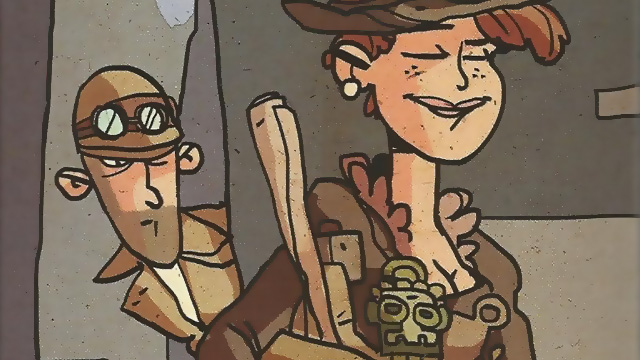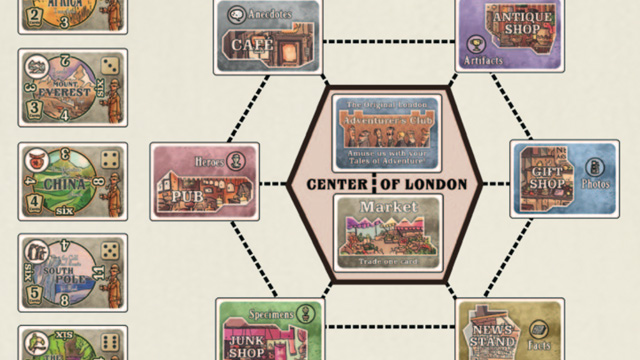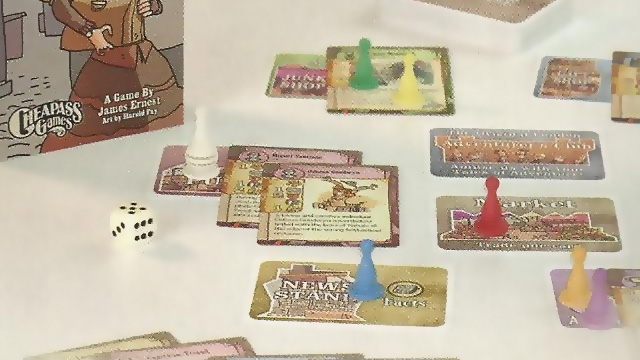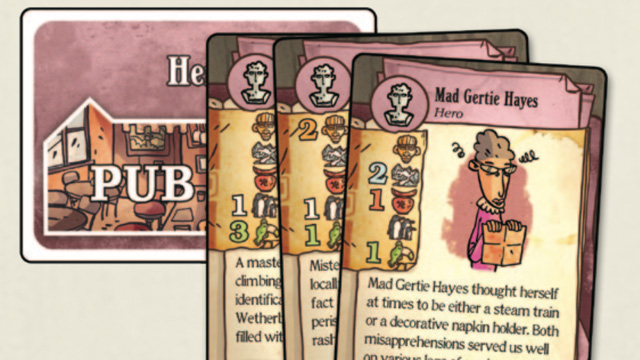
As a member of London’s famed Adventurer’s Club, you have heard countless tales of thrilling excitement. Professor Elemental’s tales are especially enthralling. There’s just one problem: they’re complete fabrications.
You’ve seen him sneaking around back streets, collecting worthless trinkets from curio shops and overhearing anecdotes in pubs that he then weaves into his bogus tales of adventure. You could call him out on it if you wanted to. But instead you’ve decided that two (to six) can play this game…
That is the premise of Stuff and Nonsense, loosely based on the theme of Cheapass Games’ own Captain Park’s Imaginary Polar Expedition from 2002 with new mechanics. Players sneak around London collecting “evidence” of their amazing travels, trying to avoid being caught by Professor Elemental as he does the same. If they encounter the Professor, they must either discard a card or lose points equal to the cards in their hand.
Eight cards are dealt out to their corresponding locations at the start of the game. On their turn, a player can move one “step,” either from one adjacent shop to another or to or from one of the two locations in Central London (Adventurer’s Club and the Market). They may then claim one of the cards at their location, if any. This cards gets replaced, and Professor Elemental might move one space clockwise depending on the new card.

Once they have enough of the right cards, players can move to the Adventurer’s Club to tell their tale. There are five possible settings for their stories (Africa, Mt. Everest, China, the South Pole and the Amazon), and only cards that have values for a given location may be used. No one is going to believe your expedition to the Amazon discovered Ice Caves, for instance. Additionally, each location has minimum requirements as to how many different types of cards you need to craft a believable tale about it.
After a successful story, points are earned according to the values of the cards played and the setting’s current bonus value. That location’s bonus value is then reduced to the next amount while a random other one’s is increased (although there’s a one-in-three chance that nothing increases). The Professor automatically moves after any story is told, which is a good way to ambush opponents with a surprise visit as well as score points for yourself. Play continues in this manner until one player reaches a given threshold of points, determined by the number of players.
Mechanically, there isn’t much to Stuff and Nonsense. Like most Cheapass titles, the fun in playing Stuff and Nonsense lies in really buying into the absurd theme.

This is aided by the ridiculous flavor text on just about every adventure card. You are by no means obligated to read these when relating your expedition to your fellow adventurers, but doing so really adds to the experience. If you want to ad-lib a little and attempt to actually tie all of the insane pieces of your tale into a cohesive narrative, so much the better.
That said, there is some strategy to be found here. Do you want to aim for a few difficult high-value stories about the South Pole and the Amazon, or do you want to concentrate on a bunch of easy tales of Africa? How does the Professor’s current location affect your plans? Is there a risk of him stumbling upon your location during other players’ turns? Can you afford to lose points or discard a card if he catches you? You also have to be aware of the types of cards your opponents are picking up; one of them might reduce your story’s bonus value by beating you to the Adventurer’s Club with a tale of the same location!

Stuff and Nonsense plays quickly, usually taking about 40 minutes or so. I find that’s just about the right amount of time to maximize the entertainment value without overstaying its welcome. This is not a game that you want to drag out. It is probably best-suited to begin or end a game night, as it’s a little too long to serve as a between-game filler and not substantive enough to be a main event. Cheapass impresario James Ernest really excels at this level of game design, and Stuff and Nonsense is another winner.
Stuff and Nonsense retails for $25. Due to the amount of reading and some suggestive subtext on a few cards, the recommended age is 12 and up.



















